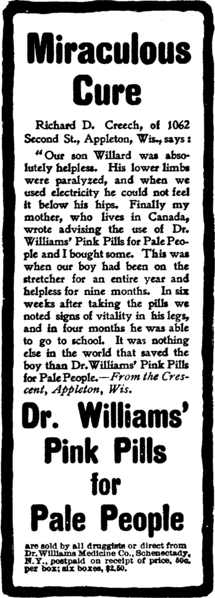
Dr. Williams' Pink Pills for Pale People
Encyclopedia

Patent medicine
Patent medicine refers to medical compounds of questionable effectiveness sold under a variety of names and labels. The term "patent medicine" is somewhat of a misnomer because, in most cases, although many of the products were trademarked, they were never patented...
containing iron oxide
Iron oxide
Iron oxides are chemical compounds composed of iron and oxygen. All together, there are sixteen known iron oxides and oxyhydroxides.Iron oxides and oxide-hydroxides are widespread in nature, play an important role in many geological and biological processes, and are widely utilized by humans, e.g.,...
and magnesium sulfate
Magnesium sulfate
Magnesium sulfate is a chemical compound containing magnesium, sulfur and oxygen, with the formula MgSO4. It is often encountered as the heptahydrate epsomite , commonly called Epsom salt, from the town of Epsom in Surrey, England, where the salt was distilled from the springs that arise where the...
. http://www.kshs.org/cool3/pinkpills.htm It was produced by Dr. Williams Medicine Company, the trading arm of G. T. Fulford & Company. It was claimed to cure chorea
Chorea (disease)
Choreia is an abnormal involuntary movement disorder, one of a group of neurological disorders called dyskinesias. The term choreia is derived from the Greek word χορεία , see choreia , as the quick movements of the feet or hands are vaguely comparable to dancing or piano playing.The term...
, referenced frequently in newspaper headlines as "St. Vitus' Dance," as well as "locomotor ataxia
Locomotor ataxia
Locomotor ataxia is the inability to precisely control one's own bodily movements. Persons afflicted with this disease may walk in a jerky, nonfluid manner. They will not know where their arms and legs are without looking, but can, for instance, feel and locate a hot object placed against their feet...
, partial paralyxia, seistica, neuralgia rheumatism, nervous headache, the after-effects of la grippe, palpitation of the heart, pale and sallow complexions, [and] all forms of weakness in male or female."
History
In 1890, G. T. Fulford & Company obtained the rights to produce Dr. Williams' Pink Pills for Pale People, and began marketing it through Dr. Williams Medicine Company. Reverend Enoch Hill of M.E. Church of Grand Junction in Iowa, endorsed the product in many 1900s advertisements, saying that it energized him and cured his chronic headaches. Eventually, the product came to be advertised around the world in 82 countries, including its native CanadaCanada
Canada is a North American country consisting of ten provinces and three territories. Located in the northern part of the continent, it extends from the Atlantic Ocean in the east to the Pacific Ocean in the west, and northward into the Arctic Ocean...
, the United States
United States
The United States of America is a federal constitutional republic comprising fifty states and a federal district...
, and the United Kingdom
United Kingdom
The United Kingdom of Great Britain and Northern IrelandIn the United Kingdom and Dependencies, other languages have been officially recognised as legitimate autochthonous languages under the European Charter for Regional or Minority Languages...
.
In the early 1890s, the publicity for the product was written by John MacKenzie. In 1892, he was made manager of the medicine company, and held that position until his retirement in 1929. When George Taylor Fulford, Sr., the Canadian senator that founded G. T. Fulford & Company, died in 1905 in an automobile accident, George Taylor Fulford II became involved in the family business.
Today, the home of George Taylor Fulford, Sr. in Brockville, Ontario
Brockville, Ontario
Brockville is a city in Eastern Ontario, Canada, in the Thousand Islands region. Though it serves as the seat of the United Counties of Leeds and Grenville, Brockville is politically independent and is grouped with Leeds and Grenville for census purposes only.Known as the "City of the 1000...
, Fulford Place
Fulford Place
Fulford Place is the turn-of-the-century mansion home of Senator George Taylor Fulford, a Canadian businessman and politician. The home is now a historic house museum reflecting Edwardian period decorations, and is operated by the Ontario Heritage Trust. It was designated a National Historic Site...
, is a tourist attraction that showcases the success of patent medicine products. It was acquired by the Ontario Heritage Foundation in 1991. In 2001 they formally put a plaque outside his home with a brief biography.

